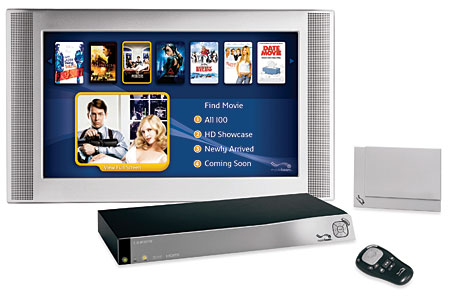MovieBeam MB2160 Video On Demand System
Sometimes an idea is so appealing—world-shaping concepts like communism, capitalism, free love, or spandex clothing—that it blinds believers to shortcomings that are otherwise glaringly obvious to those on the jaded, dispassionate periphery. We may look down our noses and scoff, yet it's hard to dismiss the power of simple belief.

Some paradigm-shaking philosophies don't get as much press as others, such as the inalienable right of all people not to suffer the tyranny of the local video-rental store. Who among us hasn't felt the sting of the late-fee lash? How many have groused about the return trip back to the movie bastille—only to realize that the rented DVDs are already a day overdue?
Netflix struck a blow for freedom and turned your mailbox into your rental store. Choosing a movie no longer involved interaction with a teenage malcontent. Input from thousands of your motion-picture-loving peers created viewing recommendations (although they were sometimes a little off base). You could queue up movie requests to ship automatically so you wouldn't have to stand in the rental-store aisles saying, "Now what the heck was the name of that movie I wanted to see?"
But Netflix can't provide the immediate gratification you get from the local video store. As fast as Netflix turns around movies—I've received new rentals within two days of sending old ones back—you still have to wait for the postman (who thankfully doesn't always ring twice) to bring you fresh entertainment.
Vive la MovieBeam
As you can tell, I really don't like dealing with video-rental stores. They've served their purpose in the world—like bell-bottom trousers—and now I'd like never to be seen in one again. But, as much as I love Netflix, its non-immediacy still ends in a few disheartening Friday nights when I find myself grumbling all the way to you-know-where.
MovieBeam is opening a second front in the war on the rental store, attacking the corner movie emporium's instant-gratification advantage head-on. The service holds out the hope of eliminating Friday-evening drives and standing in line with 20 other people who don't want to be there while the dude at the counter checks if the store's sole copy of Barbarella has been returned.
MovieBeam is a video on demand (VOD) service that provides access to 100 movies at a time. You can pick your movie while you sit on the couch, watch it, and then happily go on with your life knowing there's no disc to drop off on your way to work Monday morning. Adding to the revolutionary allure, MovieBeam doesn't charge a monthly subscription fee or require an annual contract. You buy the player ($100) and pay only for the movies you watch.

The Goods
The MovieBeam system consists of the MovieBeam player, a small antenna, and the unit's small, gourd-shaped remote control. The player itself is a low-profile basic box with a power button on the left and a menu control pad on the right of the front panel. The video outputs range from composite to component (480p) and HDMI (720p). The audio outputs include analog stereo, optical digital, coaxial digital, and HDMI. There's also a composite video/analog stereo passthrough (in case your system is out of available inputs) and a phone-jack connection you can use to update your billing information every now and then.
Inside the player's chassis is a 160-gigabyte hard drive that stores the current week's assortment of 100 movies. When you order online from www.moviebeam.com or at a retail store, MovieBeam ships a player preloaded with the service's most current movie lineup. After you hook up your player and make a phone call to set up your account, you can start renting and watching movies. The process is so quick and easy that the total time from when you first open the box to the moment the opening credits of your first movie begin is less than what it would take to drive to the rental store and back.
Bring on the Movies
Many of the movies are new releases, and some are available to watch the same day the movie is released on DVD. Twenty-four-hour rentals of new releases in standard definition are typically $4 each. Older movies rent for as little as $2 each. But MovieBeam doesn't limit you to standard definition—a handful of movies are also available in high definition. HD versions usually cost a buck more than the SD versions, which is one heck of a bargain. However, they're only available via the HDMI connection (or a DVI connection that supports HDCP). If you're using component video (or lower), the player won't even offer you the option of renting in HD. The best you'll get is 480p.
Each week, MovieBeam replaces up to 10 of your stored movies with 10 different ones, thanks to their datacasting technology. This uses a network of PBS stations around the country that continually broadcasts bits of new movie data. (You have to live in a major metropolitan area within reach of a MovieBeam signal, or the process won't work. MovieBeam's Website can tell you whether your area is covered.) Throughout the week, the player automatically assembles the data into new movies and deletes old ones from your hard drive.
Because MovieBeam sends out one master signal, every active MovieBeam player has the same lineup of movies. In other words, you can't request your own titles. An Ethernet port on the back of the player may allow that in the future, but the system's initial intent is to function as the equivalent of the rental store's "new releases" wall. Unlike the rental store, however, no matter how many MovieBeam customers rent a particular movie, it's always available on your player.
Simplicity
I like the MovieBeam concept a lot—maybe even too much—and I have a tendency to gloss over its faults. The system's attractiveness comes from its incredible simplicity. Hookup is about as easy as any A/V component's can be. The user interface is equally simple. (It's so simple that my 6-year-old has very few problems navigating it.) Movies download automatically, there are no discs to fumble with or scratch, and MovieBeam automatically tallies your rental fees and charges your account once a month. And, since there's no subscription fee or contract, it won't cost you anything if you choose not to use it (while you're on vaction, for example).
The system does have its share of problems, however, most of which are relatively insignificant. Not all studios are represented, the new-release selection isn't as broad as I'd like to see, a small number of movies are presented in full-screen format while the DVD is available in widescreen, and it would be nice if more movies were available in HD.
 MovieBeam's most glaring fault, however, is not so easy to shrug off. The picture quality varies from movie to movie and can exhibit a lot of compression artifacts. Even on a smaller screen, critical eyes will notice that the image isn't always up to that of a DVD. The problem seems to be more pronounced on the $2 catalog movies than on the newer $4 releases. The Chronicles of Narnia, for example, looked pretty darn good, but artifacts were plainly visible during scenes with lots of motion in The Saint. (The MovieBeam folks tell me the differences are often the result of the varying quality of the masters they receive from their studio partners.) At other times, the MovieBeam version looked a bit softer than the same movie on DVD. HD movies are significantly better than DVD quality, but they don't quite live up to what you'll see on a really spectacular HD feed on cable or satellite. On the other hand, I've seen plenty of HD broadcasts that look worse than what you'll see with the MovieBeam, so go figure.
MovieBeam's most glaring fault, however, is not so easy to shrug off. The picture quality varies from movie to movie and can exhibit a lot of compression artifacts. Even on a smaller screen, critical eyes will notice that the image isn't always up to that of a DVD. The problem seems to be more pronounced on the $2 catalog movies than on the newer $4 releases. The Chronicles of Narnia, for example, looked pretty darn good, but artifacts were plainly visible during scenes with lots of motion in The Saint. (The MovieBeam folks tell me the differences are often the result of the varying quality of the masters they receive from their studio partners.) At other times, the MovieBeam version looked a bit softer than the same movie on DVD. HD movies are significantly better than DVD quality, but they don't quite live up to what you'll see on a really spectacular HD feed on cable or satellite. On the other hand, I've seen plenty of HD broadcasts that look worse than what you'll see with the MovieBeam, so go figure.
I can't imagine that MovieBeam couldn't improve the picture quality in the future by adjusting the compression rate, albeit at the expense of storage space. It might not be as catchy to promote 96 movies instead of 100, but I'd suggest exchanging a bit of quantity for better picture quality.
The Revolution
So the quandary is, should you believe in the revolutionary power of simplicity to change the world of video rentals and, for the moment, accept the image quality in the hopes of better days ahead? Or do you stand firm in your convictions and dedication to the ultimate picture, despite the time and gas money you squander going to the rental store? In my house, I'm the only one who complains about the image-quality issues. Everyone else is so blasted happy with the gadget that it's difficult not to be infected with their enthusiasm.
My recommendation—if you want to free yourself from the video store—is to buy a MovieBeam system and get a Netflix subscription. The first provides popular titles immediately, while the second gives you access to a deep catalog of movies, some of which you might not have known you wanted to see before Netflix recommended them. That way, when friends bring the urge to watch a movie to your home, your only options won't be limited to either admitting that all you have is a copy of Hamlet (starring Patrick Stewart) from Netflix or pulling out your car keys and driving to the video store. You can watch Dave Chappelle's Block Party on the MovieBeam instead.
Save the gas. This revolution will not be motorized.
Highlights
• Easy-to-use interface
• Good selection of current movies
• No subscription fees or contracts
- Log in or register to post comments

























































